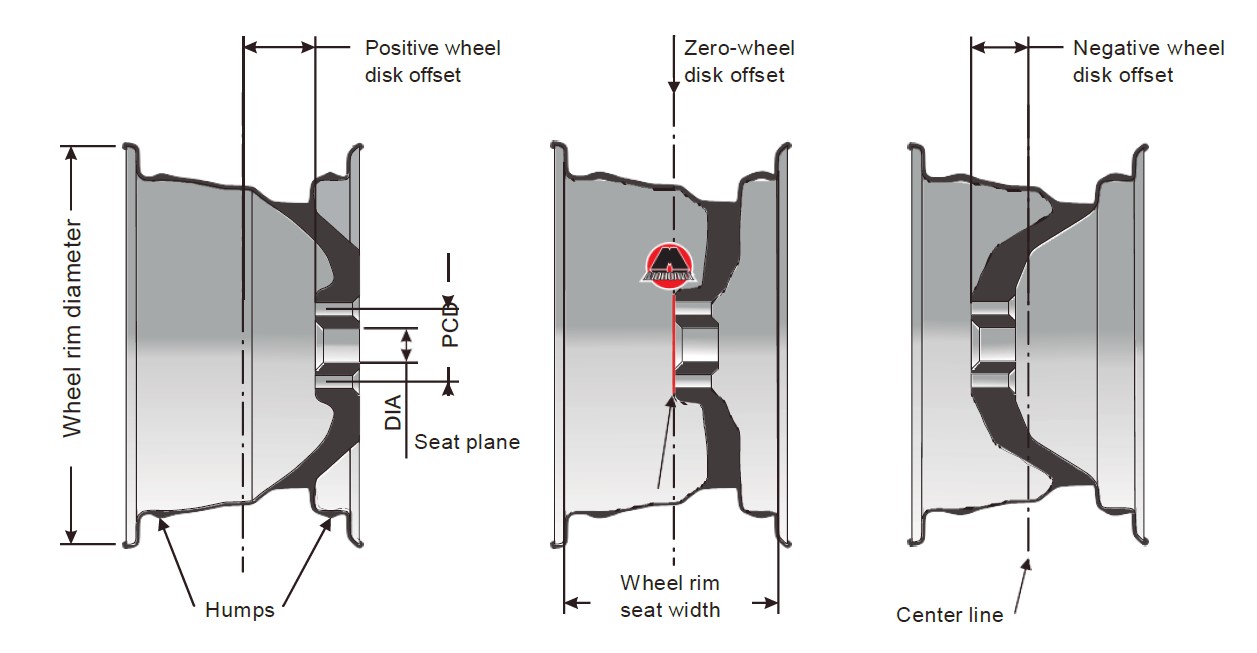6.2.14 Wheel markings

Figure 6.27 Wheel.
It is useful to know the tire markings, since the tire is put on the rim, which also has its own marking, and it must correspond to the selected tire.
For example, the marking "8.5J x 17 H2 5/112 ET 35 d 66.6" on the wheel has the following decoding:
Note
The wheel designation is applied to the inner surface. It should be also duplicated on the packaging and be available in the accompanying documentation or stickers.
8.5 is wheel rim width in inches. The given size must necessarily correspond to the width of the tire;
Note
A tire with a width, which does not match the width of the wheel, may come off while driving.
x is a sign between the symbols for the width and the rim diameter, which indicates that the wheel rim is one-piece;
17 is the rim diameter of the wheel in inches, which must necessarily correspond to the rim diameter of the tire;
Note
Wheels with a diameter of 12 to 32 inches, the most common diameters are 14-16 inches, are used on passenger cars.
J is a coding letter, which informs about the design features of the rim flanges (inclination angles, radii of curvature, etc.);
Н2 — the letter "H" (abbreviation for the English word "Hump") indicates the availability of annular protrusions (so-called humps) on the shelves of the rim, which keep the tubeless tire from jumping off the wheel rim. Often there are two humps on the wheel (designation "H2"), but there can be one hump (designation "H"), they can have a flat shape (FH - "Flat Hump"), be asymmetric (AH - "Asymmetric Hump"), combined (CH - " Combi Hump ");
5/112 – PCD ("Pitch Circle Diameter" - the diameter formed by the centers of the holes for the wheel mounting). The number "5" indicates the number of mounting holes in the wheel for bolts or nuts (most commonly wheels have the number of mounting holes from 4 to 6, less often - 3, 8 or 10). "112" is the diameter of the circle formed by the centers of the mounting holes, in millimeters. There are a number of such diameters - for example, 98; 100; 112; 114.3; 120; 130; 139.7 and some others. Often they are used by manufacturers according to tradition or as the most suitable for vehicles for a particular purpose - for example, size 139.7 is typical for pickups and SUVs;
ET – designation of the size of the wheel disk offset in millimeters;
Note
Wheel disk offset (see figure 6.27) is the size between the seating (attachment) plane of the disk, which is adjacent to the wheel hub, and the axis of symmetry of the wheel rim. In case if the plane of contact with the wheel hub is “outside” with respect to the axis of symmetry, the overhang of the wheel disk is called positive, for example, ET35. In case if it is "from the inside" (closer to the car) - the offset is negative, for example, ET-20. Simply put, the more the wheel protrudes outside the body, the lower the offset value. In case if the offset designation is zero, then the contact surface with the wheel hub lies on the axis of symmetry of the wheel rim.
Note
Installing wheels with a reduced offset if compared to the standard offset can provide a different appearance of the car. However, such a turn of events can negatively affect both the handling and the life span of the wheel bearings.
d is hub diameter or center bore diameter in millimeters.
Noteе
In the best case, this diameter shall correspond to the diameter of the seat face on the hub.
Note
Always use only special bolts and nuts for securing the wheels.



















2 MB